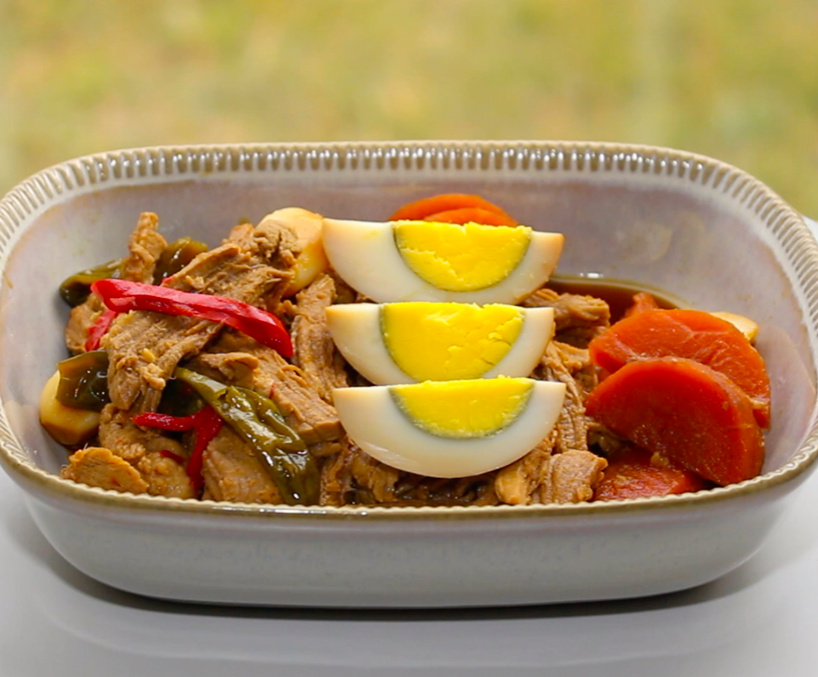Tender and Juicy Pork Jangjorim (Soy-Braised Pork)
Make Delicious Pork Jangjorim That Requires No Other Side Dishes!

Experience the irresistible savory and sweet soy sauce-marinated pork jangjorim that’s so tender, you won’t need any other side dishes! Adding perfectly boiled eggs makes this a hearty dish that nourishes both body and soul. Serve it with warm rice for a meal that disappears in a flash! It’s a comforting and satisfying side dish that everyone from kids to adults will love.
Main Ingredients- Pork (Pork shoulder or butt) 600g
- Hard-boiled eggs 3
Cooking Instructions
Step 1
First, cut the 600g of pork into large pieces, about 6cm long, suitable for jangjorim. Cutting them too small might cause them to break apart during cooking, so aim for a substantial size.

Step 2
Soak the cut pork in cold water for about 20 minutes to drain out the blood. Thoroughly removing the blood is key to creating a clean-tasting jangjorim without any gamey odor.

Step 3
Prepare the vegetables for the broth. Cut the leek (1 stalk) into large pieces, about 6-7cm long, then cut each piece in half lengthwise. This helps to extract more flavor into the broth.

Step 4
Cut the half onion into 3 large wedges. If cut too small, it might disintegrate during simmering.

Step 5
Peel the ginger and cut it into 3 or 4 large pieces. Ginger is excellent for removing any unwanted odors from the meat.

Step 6
Cut the 1/3 carrot into bite-sized pieces, about 0.5cm thick. You can also cut them into your preferred shapes.

Step 7
Using a fork or toothpick, poke several holes in the Cheongyang chili peppers. This allows some of their spiciness to infuse the sauce gently, making it palatable without being overwhelmingly hot.

Step 8
Similarly, poke holes in the Korean green chili peppers (Ggwarigochu) with a fork. Their crisp texture and unique flavor will add another layer of deliciousness to the jangjorim.

Step 9
Trim the ends of the red chili pepper. Then, use a chopstick to carefully remove the seeds and pith from the inside. Removing the seeds helps maintain a clean color in the final dish.

Step 10
Slice the deseeded red chili pepper diagonally into about 0.5cm thick pieces for garnish.

Step 11
Place the drained pork in a pot of generously salted water and blanch for about 10 minutes. Add the 2 bay leaves and 4 Tbsp of cooking wine during this step to effectively remove any gamey smell from the pork.

Step 12
Remove the blanched pork, rinse it lightly under cold water to clean off any impurities, and then drain thoroughly on a colander. This ensures a cleaner flavor profile for the jangjorim.

Step 13
Now, let’s make a flavorful broth. In a pot, combine 600ml of water with the prepared leek, Cheongyang chili peppers, onion, and ginger. These vegetables will create a savory base for your jangjorim.

Step 14
Once the vegetable broth comes to a rolling boil, add the prepared pork and simmer for another 10 minutes. Then, remove the pork to cool separately. You can discard the vegetables, but keep the broth! This broth will add depth of flavor to your jangjorim.

Step 15
Once the pork has cooled slightly, shred it by hand along the grain into bite-sized pieces. Shredding allows the sauce to penetrate better and results in a more tender texture compared to slicing.

Step 16
To the broth from which the pork was removed, add 150ml of soy sauce, 1 Tbsp sugar, and 1 Tbsp oligosaccharide. Stir well and bring to a simmer. This is where your delicious savory-sweet jangjorim sauce is created.

Step 17
When the soy sauce mixture is bubbling vigorously, add the sliced carrots, whole garlic cloves, poked Korean green chili peppers, sliced red chili pepper, and the shredded pork. Let everything simmer together, allowing the flavors to meld beautifully.

Step 18
Finally, add the 3 hard-boiled eggs and let the mixture simmer over low heat until the sauce thickens to your desired consistency. Stir occasionally to prevent the sauce from burning. Once the sauce has evenly coated the pork, vegetables, and eggs, your delicious pork jangjorim is ready! Serve it over warm rice and enjoy!



